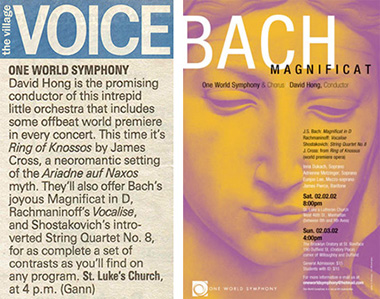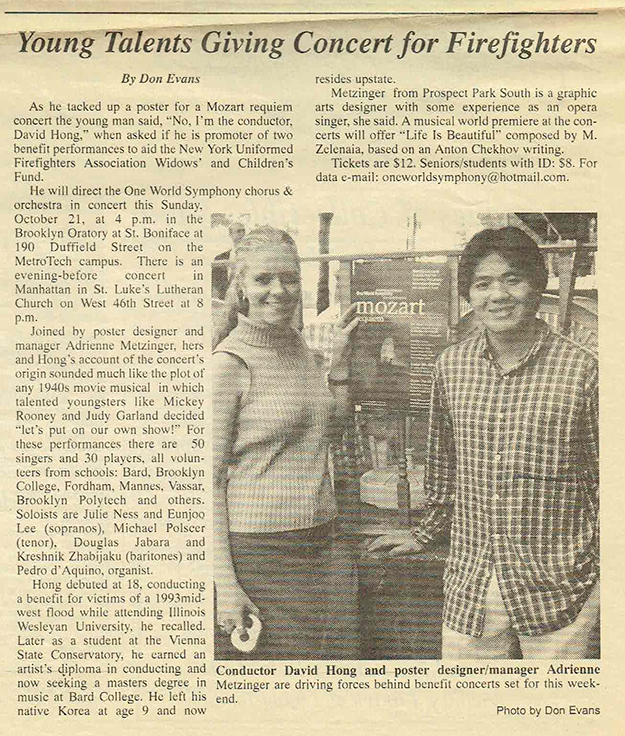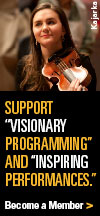One World Symphony News: 2001-2004
November 2004
 Cello-Brate Good Times: Due to popular demand, One World’s cello festival returns
Cello-Brate Good Times: Due to popular demand, One World’s cello festival returns
By Kevin Filipski, The Brooklyn Paper
One World Symphony’s first "Cellobration" was such a big hit last fall that it is being revived as an annual event, according to artistic director, founder and conductor Sung Jin Hong.
"The first ’Cellobration’ was very popular and well-received, both from our cellists and our audiences," Hong told GO Brooklyn. "A lot of our audience members actually e-mailed us to see if we were going to program another cello concert. The Villa-Lobos piece (’Bachianas Brasileiras No. 5’) got such an ovation that we repeated it. Also, you don’t get to perform with 16 great cellists at the same time too often, so it was amazing just for that."
For One World Symphony’s second "Cellobration" (Dec. 3 at the Church of St. Ann and the Holy Trinity in Brooklyn Heights), Hong and One World Symphony are giving their audiences more of what worked so well last time: Bach; the Brazilian, Heitor Villa-Lobos; and two local premieres.
"And most of the cellists are coming back, too," said Hong.
But the program is built around Bach.
"The big tree trunk is Bach, and then you have all these other branches, which are the other composers [we’re playing]," said Hong. "Bach is the one composer who really inspired Villa-Lobos, and Villa-Lobos inspired [Gaspar] Cassado, while Stanley Grill is a fascinating composer with Latin elements in his music."
One World Symphony’s concert begins with Bach’s "Chaconne" - a movement from his Partita No. 2 for unaccompanied violin, arranged for cello orchestra by Laszlo Varga - which is one of his most emotional and joyous pieces.
"Bach’s ’Chaconne’ is such a monumental piece that many composers have transcribed it and arranged it for various instruments, like [Ferruccio] Busoni’s massive Wagnerian arrangement for piano," Hong noted. "I’ve even heard a rock band version.
"There are so many composers, even today, who are so inspired by this piece," he said. "It’s transcendent. It goes way beyond the notes, and it has a real depth. I truly believe that this is music that takes us all on a meaningful journey. The cellists are more excited about playing this than anything else on the program."
Following the Bach work comes Villa-Lobos’ "Bachianas-Brasileiras No. 1." As its very title indicates, it was one of 11 pieces the Brazilian master wrote in homage to the composer he revered among all others, Bach.
"These 11 works are written for solo instruments, chamber ensembles and full orchestras; and there are two that are written for cello orchestra, numbers 1 and 5," Hong explained. "The one we’re playing is directly inspired by Bach. No. 1’s last movement is a fugue. You have eight different parts talking together, just like an extensive Bach fugue - and Bach was the father of the fugue."
"[Villa-Lobos’] first movement clearly depicts his own Latin background with this heartbeat Latin rhythm," he continued. "He wants to make a statement, right in your face, right off the bat. So playing this is a perfect fit for us."
"Suite for Cello," by Spanish composer Gaspar Cassado, is next on the program.
"I was thinking about programming a Bach cello suite, but then I thought it was more adventurous to do this," Hong admitted. "Cassado’s suite is directly related to the Villa-Lobos piece; it also has three movements, and it ends with a Bach-like fugue."
The closing work of this season’s "Cellobration" is written by One World Symphony’s resident composer, Stanley Grill. His "Vignettes - Winter Trees" is scored for two cellists and two mezzo-sopranos.
"[Grill] originally wrote it for two bass voices and two cellists, but I suggested he change it [to mezzos] because I thought those two pairs would compete," said Hong. "It’s a work in progress: he’s writing 10 movements in total, and we’re performing four of the movements.
Grill’s "Vignettes - Winter Trees" is a setting of poems by William Carlos Williams.
"There are layers of meaning in the poems that you can interpret so many ways," said Hong. "From my experience, the poems are visually compelling; just physically the way Williams laid out his poems can be interpreted in many different ways."
Hong acknowledged that a song cycle written without any piano accompaniment is a daring choice.
"Getting rid of the keyboard instrument limits the composer," he says. "Now it’s basically a quartet for four solo voices - and the two cellists are voices without words. The cellos lay down the texture and the overall feeling of the poem, while the singers express the text. It’s actually quite innovative."
April 2004
Report/Review
on One World Symphony's "The Marriage of Figaro"
by H. Michael Jahilil
Music for Everyone
When Sung Jin Hong was fourteen years old, he saw a girl play Beethoven's Für Ellise on the piano in a McDonald's commercial. His passion for music was born, and soon he was dreaming of conducting a full-scale symphony orchestra.
Three years ago, 25-years-old Hong founded One World Symphony. Comprised of young professional artists who donate their time and skills, One World offers a new program of symphonies, operas, or new music every month throughout New York City. After his orchestra performed Mozart's The Marriage of Figaro, Hong said, "I felt like the luckiest person alive because the performance from all the musicians was so committed and inspring."
One World Symphony musicians are volunteers or receive a small honorarium. Thirty-year-old timpanist Ed Gonzales said, "We play with this orchestra because of the atmosphere [Hong] creates." They also come for the audience and to be nourished by the music. Tickets to One World Symphony concerts cost a fraction of the price of similar acts at established performance halls.
Don Rollins who has been attending One World Symphony concerts for more than a year, said, "This is a full-blown opera, they may not have the scenery, like the stage, but the caliber of the music, the singers and the musicians, gets very close to the Metropolitan Opera."
Admission to each performance costs less than $25 (at the Metropolitan Opera even a weeknight balcony seat costs $60). Mark Shahon, 50, a sales associate, volunteers as an usher for One World Symphony shows and says this orchestra has exposed many of his friends to live, quality music that they could not afford to hear otherwise. "There is so much lousy music," Shahon said, "because people can't afford to listen to live music like this."
During an intermission in a recent performance, Hong turned to the audience and expressed his appreciation for the musicians who make the financial sacrifice of turning down other offers to play for the One World Symphony. He introduced one violinist, Tarrah Reynolds, 24, and asked her, "Every time you perform with us, you lose money. Why do you keep doing this?" Reynolds replied, "Because it's fun and a good cause and too many people do music just for money."
Hong, a music lover and a dreamer, founded One World Symphony in 2001. "Seven or eight musicians, we met in coffee houses, and eventually founded this orchestra. You know, there are so many coffee houses in New York," Hong said.
Joan Dawidziak, 40, a former nurse who is now a freelance musician, met Hong at a book signing in Barnes and Nobles five years ago. "He promised me there he would start an orchestra. He kept his promise," Dawidziak said.
A few months after their founding came Sept. 11, 2001. In the orchestra's appearance after the tragedy, One World Symphony changed its planned program and performed Mozart's Requiem as a benefit concert. "It was such a healing event," Hong said. "All the performers and audience members felt something beyond the music, we really connected with what Mozart wrote."
Twenty-eight-year-old flutist and a One World Symphony founding member, Stefan Hoskuldsson, recently landed a job with the Metropolitan Opera as the second flutist. "Stefan went from a non-paying orchestra to the highest-paying orchestra job in the world. He gives hope for so many young artists," Hong said.
To foster fraternity between singers and musicians, Hong brings dinner for the artists. Liz Player, who plays the clarinet and teaches at Midori and Friends, an organization founded by Midori, the famous violinist, said, "This group feels like a community where the opera singers and musicians mingle."Hong has also won performers over with his leadership style. In the circle of artists, Hong is known as a different kind of conductor. Gonzales said, "When there is a problem, he fixes it without emotionally violating anybody." Dawidziak, who plays oboe, said, "It's a common trait of conductors to be abusive, [Hong] is not, instead of getting people's fear, he has his group's respect."
New York has an overabundance of aspiring artists and many hardly find the chance to perform. The One World Symphony gives young singers like Jennifer Greene a chance to perform and grow. Greene, 24, a music instructor at Mannes College of Music, has sung with One World Symphony since September 2003. She says it has been a great opportunity for her to sing opera with a fine symphony, an chance rarely given to young singers, and to perform with professionals. Her family traveled from Iowa to see her lead role in The Marriage of Figaro.
Hong grew up in Seoul, Korea, Los Angeles, and Peoria, Illinois, and studied music in Illinois, New York and Vienna, Austria. In Vienna, he said, his teacher encouraged him to go to New York because it is the suitable ground for entrepreneur musicians. When he came to New York in 1999, he played piano and violin in cafes, tended bar and worked as a food caterer. He now is a freelance musician and teacher.
Many members of One World Symphony have expressed that one of the keys to Hong and One World Symphony's sucesses is due to Adrienne Metzinger. She is a founding member, managing director, graphic designer, soprano who was a soloist in its production of The Marriage of Figaro, and Hong's girlfriend. At times, he and Metzinger have to dig into their limited earnings to pay the orchestra's expenses. "We decided to become musicians not for financial reasons but for the joy and love of music," Hong said.
The man whose musical aspirations were inspired by a hamburger commercial dreams of the chance to play Beethoven's Ninth Symphony, Ode to Joy, for the crowds at Yankee Stadium and Chicago's Wrigley Field. "I don't enjoy intellectual concerts. A great conductor and humanitarian once told me that intellectualism is limited; imagination is beyond intellect and is limitless. I'd like to make music that inspires and connects with the masses."
H. Michael Jahili
Reporter
Columbia University
February 2004
 ALL FOR ’LOVE’ – One World Symphony delivers ’Love Letters’ program to Brooklyn Heights audiences
ALL FOR ’LOVE’ – One World Symphony delivers ’Love Letters’ program to Brooklyn Heights audiences
By Kevin Filipski, The Brooklyn Paper
Sung Jin Hong will conduct the One World Symphony in a unique Valentine’s Day program - aptly titled "Love Letters" - on Feb. 13 at the Church of St. Ann and the Holy Trinity, in Brooklyn Heights.
"All of the works were chosen for their sheer feeling of romantic love," Hong told GO Brooklyn in an exclusive interview.
"Love Letters" juxtaposes five works with excerpts of letters from composers on the program and their loved ones, read by two actors.
"The crux of the program is Mahler’s ’Adagietto,’ a short movement from his Fifth Symphony," said Hong, "which has become very well-known through the [1971] movie [by Luchino Visconti] ’Death in Venice,’ where it was featured very prominently."
In a move away from conventional concert practice, the orchestra will play Mahler’s "Adagietto" twice.
"It’s a very passionate work, and our two performances of it will show that," Hong explained. "The first time will be the modern orchestral setting where the violins are all together, but in Mahler’s era, he wanted the violins across from each other because of the way that he wrote - he composed lots of counterpoint between the first and second violins, and this is a very effective way for audiences to hear it.
"The major advantage is that the audience will be able to experience two ways of hearing Mahler’s work," he said. "I will ask the audience during the concert if they hear a difference between both ways of performing it."
For Hong, this encore makes the concert a new experience for audiences.
"Orchestras are struggling and are looking for ways to survive and gain audience support," said Hong. "We’re trying to find our own creative ways of doing that without being too lecturing or intellectual - this is the way Mahler wanted it heard, so let’s see if there’s a difference to our ears."
While at the podium, Hong, who just won a spot as an active conductor in Kurt Masur’s Conducting Seminar at the Manhattan School of Music Symphony, is in position to manipulate the audience’s experience.
"I’m tempted to perform it two ways," he said. "There’s the original, slow, weighty, tragic way, which was made famous by conductors like Leonard Bernstein, and then there’s the ’love letter to Alma’ [Mahler’s wife] way, which is less ponderous but still dramatic. When I conduct, I like to move it along and let the music speak for itself."
Following the Mahler work, a movement of Beethoven’s final string quartet, "Cantate," will be played in an arrangement for string orchestra. That final quartet was dedicated to Beethoven’s nephew, with whom he shared a close relationship throughout his life, which is how it fits into this program. Hong also sees a link between "Cantate" and Mahler’s "Adagietto."
"Mahler was directly influenced by Beethoven’s last string quartet," Hong explained. "Both Beethoven and Mahler were revolutionaries - the sheer length and difficulty of Mahler’s symphonies harks back to Beethoven’s last string quartets," which were - and still are - considered among the most complex music ever written, with the partial exception of the relatively straightforward last quartet.
Also on the program is Brahms’ "Ophelia Lieder," originally scored for voice and piano, here orchestrated by composer Aribert Reimann for strings, and sung by mezzo-soprano Natalie Anne Havemeyer, a Bronx resident.
"That’s a real interesting piece, re-orchestrated very simply and sensitively," Hong noted. "Ophelia’s madness is depicted in a very gentle way. And Natalie is a fantastic vocal artist who will sing in our ’Marriage of Figaro’ in March."
Leos Janacek’s second string quartet, titled "Intimate Letters" after his correspondence with his late-career muse, Kamila Stosslova, is represented on this program by its slow movement. Some of Janacek’s and Stosslova’s letters - along with Mahler’s and wife Alma’s - will be excerpted during the concert.
Last but not least, a short work by Park Slope resident Gary Sunden will be played. His seven-minute "Vivace for Strings," composed in 1995 as the prelude to an opera Sunden adapted from Moliere’s "Sganarelle, ou le Cocu Imaginaire," came to Hong’s attention in quite a strange way.
"Gary’s actually a lawyer who has been attending our concerts, which I wasn’t aware of," said Hong. "He wrote a nice letter to me complimenting us and telling us that he believed in our mission, and I thought, ’What does this lawyer know about music?’
"But I listened to his work and it was very fresh to hear," said Hong. "The opera the prelude is from is about two young lovers, so it fits into the theme of our program - I was surprised at how well it does fit. He’s very excited to hear it played ... just as we are to play it."
BACH TO BRAZIL: A CELLOBRATION
(published in the Newsletter of the Internet Cello Society)
Friday, September 26, 2003, the One World Symphony under the baton of its brilliant, young conductor, Sung Jin Hong, gave a resplendent and poetic concert in the charming St. Ann and the Holy Trinity Church in Brooklyn, New York. The concert was what Hong called a "cellobration," since it featured works for solo cello, cello and piano, dance and compositions for a cello choir of One World Symphony’s entire section of 15 cellists with another cellist driving all the way from Urbana, Illinois, and a 17th cellist flying in from Hunstville, Alabama.
Now in its third season, One World Symphony is a group of highly regarded up-and-coming musicians and vocalists from the four corners of the globe and representing the wide diversity of the world’s cultures, ethnicities, and languages. Korean-born Sung Jin Hong explains that One World Symphony was founded to program music inspired by different cultures to increase musical diversity in the concert hall, audience awareness of music from all parts of the world, promote music by living composers and offer fresh interpretations of the classic repertoire.
"My idea in this year’s Embracing the Influence series of concerts," the conductor explains, "is to examine the nature of 'influence' in contemporary music by juxtaposing new works with those in the accepted canon. The first part of this concert, for example, illustrates the lineage from Bach to Brazil. Considered to be among the finest examples of solo instrumental composition, Bach’s cello suites continue to move and inspire, influencing centuries of audiences and composers. So where else, " Hong asks, "could our program begin but with one of these epochal works, the intimate and intense Cello Suite in C Minor?" He points out that, "hundreds of years later and a continent away, Heitor Villa-Lobos, the great Brazilian composer, penned his homage to Bach’s genius, the lyrical and inventive Bachianas Brazilieras No. 5, for soprano and cello orchestra. The final link in this chain of association is a New York premiere by Robert Below, Homage to Villa-Lobos for Cello Orchestra, an expansive and original tonal refelection on the Brazilian master.
In the second half of the program," Hong continues, "we begin with a movement from one of the most significant and powerful chamber works of the 20th century, Quartet for the End of Time, written by the French composer Olivier Messiaen, when he was a prisoner of war in a concentration camp during World War II. Accentuating our performance of the 'Infinitely Slow' movement for cello and piano will be the world-premiere choreography by Takehiro Ueyama and dancers from the Paul Taylor Dance Company. The program ends with a work by the important contemporary composer, Joan Tower, Hommage à Messiaen, a literal tribute to the 'Infinitely Slow' movement and a profound exploration of the flow of time, ideas, and events."
Friday night’s concert opened with the Bach Suite No. 5 in C Minor for solo cello played with great warmth and dynamic expression by Sophie Shao, the recent winner of the International Rostropovich Cello Competition. This suite of seven movements was a powerful introduction to a concert featuring cello compositions, since Ms. Shao beautifully demonstrated how the cello with its very wide range of sounds from low bass to very high notes can sound in some ways like a whole orchestra. With total command of the instrument, Ms. Shao showed how the cello can play chords and parallel counter melodies like a guitar and piano as well as playing single, melodic lines like brass and woodwind instruments. Ms. Shao is a charismatic performer with a rich palette of tones, who kept the audience of adults and young children spellbound as she played animated movements with dramatic fluorish and slow movements, as in the Sarabande, with an intimate, whispering softness and loving tenderness.
A unique dimension of One World Symphony performances is the way Hong often speaks with the audience about the different compositions and there is often a short 10- or 15-minute form of audience interaction with the orchestra. Before playing the next piece, he told the audience that the composer of Bachianas Brazilieras No. 5 was a cellist and guitarist with a great love for Bach’s music. Hong briefly demonstrated two main musical characteristics of the piece with the orchestra playing a very "cello" excerpt and another where the cello orchestra sounds more like a guitar. He then asked the orchestra to play two different approaches to the same crucial part in the work -- one the way the composer instructed, the other a different way. It was very enjoyable for the audience that their vote and that of the musicians was almost unanimously for the "different way" for the most natural and convincing way to play this important part of the piece.
Soprano Melody Alesi sang the well-known Aria - Cantilena movement of Bachianas Brazilieras No. 5 with the 17 cellists often playing pizzicato accompaniment to the alluring melody and a flowing cello solo by Sophie Shao. Soprano Jennifer Greene then sang the more spirited Danza Martelo, where the cello orchestra often sounds like a guitar playing Brazilian dances. Hong’s interpretation of this demanding work brought an exquisite beauty to the undulating, plaintive first movement and glorious energy to the joyful exhiliration of the second movement. The cello choir’s playing of Below’s Homage to Villa Lobos featured an outstanding cellist from Alabama, Elizabeth Loy, with marvelously deep and full tone in this unusual composition of fascinating dissonances, counter melodies, and a surprise ending.
A highlight of the concert was a rare opportunity to hear conductor Hong playing piano, South African cellist Simone Uranovsky on cello, and the choreography of Takehiro Ueyama with Lisa Viola, Jill Echo and Orion Duckstein of the Paul Taylor Dance Company in the performance of the "Infinitely Slow" movement from Messiaen’s Quartet for the End of Time. The piece begins with the solitary sound of Ms. Uranovsky’s cello as the dancers are lying on their backs, as if dead on the floor behind her. Gradually, Hong’s slowly repeating piano chords join in like a steady heartbeat, as the dancers appear to awaken and emerge into an ever-increasing liveliness. Simone Uranovsky has a transcendent vibrato sound that sings out with extraordinary presence throughout the very long durations of the notes in this movement. Messiaen’s writing for the cello in this movement also requires many large glissando and portamento shifts, which Ms. Uranovsky expresses effortlessly with perfect intonation and a continuously fluid legato.
The building progression of Hong’s slowy resounding chords sound like church bells ringing for a funeral and Ms. Uranovsky’s high register melody resembles the tormented human cry over the death of a loved one. Suddenly at a point of high-pitched intensity, the music breaks off with a jolting silence. However, then it quietly starts up again, and Ueyama’s choreography has the dancers embracing and gracefully re-emerging into a standing affirmation with arms outstretched as if to God, as the music appears to end, stop, almost end, and then finally terminate. It was very moving for the audience to experience this spiritually uplifting composition and dance in the lovely church of St. Ann’s.
Clearly, this is one of the most difficult works for the cello, because it requires the continued holding of extremely long notes without a break in the duration and quality of sound, and Ms. Uranovksy and Hong’s reverent interpretation is expressed with deep feeling and sensitivity. First performed for the other inmates in his concentration camp, this movement from the Quartet for the End of Time appears to be a message of Messiaen to individuals facing their own imminent death that there is a God, and that life, beauty, meaning, and ultimately time itself can be affirmed to continue to exist...forever.
Amy Kim, a very gifted and prize-winning cellist from Korea, and pianist Yi-Heng Yang then played Tower’s Hommage à Messiaen. Their playing of the innovative harmonies and reflective beauty of Tower’s piece had a delicate expressiveness that brought the second part of the concert to a memorable close. As an encore, the orchestra returned to play an even more alluring and triumphant interpretation of the Bachianas Brazilieras No. 5 to a standing ovation. One audience member told Hong, "The way you and your ensemble plays, 10 more times of the Villa-Lobos would have still thrilled me!"
Sung Jin Hong and his colleagues of the One World Symphony are establishing a wonderful tradition of bringing creative, exciting, and high quality concerts to concert halls, churches, and nontraditional community venues in New York City. Hong explains that the different aims of One World Symphony are inter-related. "The way I present audience and orchestra musician interaction in each concert, for example, is not meant to be 'educational,' stuffy, or to show how much I know about music but to have our audience members get closer to the music and our musicians. The connection and the overall experience becomes much more fun and engaging."
The international composition of the orchestra and of its programs, the historical continuity of works of both past and present composers, and the forms of audience collaboration provide a special musical experience of "One World" together. The thought-provoking structure of the current season’s "Embracing the Influence" series is also sure to raise new questions about what it means to write "modern" music for the 20th century. In addition to the "Embracing the Influence" series, One World Symphony presents large-scale works, such as Beethoven’s Ninth Symphony, and will present Mozart’s Mass in C Minor this season.
You can consult their website oneworldsymphony.org for the current schedule and for further details of their forthcoming concerts in Brooklyn and Manhattan, which promise to be equally interesting and enjoyable. This is a group you do not want to miss.
March 2003
 'YOU'RE THE INSPIRATION' – Tributes to master composers
'YOU'RE THE INSPIRATION' – Tributes to master composers
By Kevin Filipski, The Brooklyn Paper
For its first-ever spring festival, Brooklyn’s One World Symphony will pair music by established composers with world premieres by composers who were influenced by them on consecutive Tuesday evenings at the church of St. Ann and the Holy Trinity in Brooklyn Heights.
David Hong, conductor and director of One World, said the series, which began March 25, grew out of the musicians’ own aspirations.
"We’d been giving concerts once a month this season, and with all the promise within the ensemble, we felt there was more we could be doing," he told GO Brooklyn.
"All our members are young, professionally skilled and dedicated musicians who believe in what they are playing," he said, "so the suggestion came that we perform once a week rather than once a month. That started the idea of experimenting with these concerts."
Hong said the orchestra aims high in such programming decisions.
"The challenge is finding the music to perform on each program," he explained. "The audience will hear the music of composers they are likely already familiar with, and then hear their influence on modern composers. We’re also featuring letters written by the major composers, read by actors or scholars. And we’re featuring four local composers alongside the better-known composers, putting this new music into the context of the great composers of the past."
Each "new" composer on the program is familiar to Hong and the orchestra and lives in the New York area: Margarita Zelenaia, whose Sonata for Flute and Piano premiered March 25, lives in Manhattan; Hong, whose "Musikverein" premieres April 1, lives in Prospect Park; Pedro D’Aquino, whose Mozart-influenced world premiere will be April 8, is a Bay Ridge resident; and John Craven, whose vocal work "To the New Day" premieres April 15, recently moved from Park Slope to New Jersey.
The April 1 concert is indebted as much to a famous Austrian philosopher as it is to the music of Richard Wagner.
"While I was at the Vienna State Conservatory, my philosophy professor was a student of Viktor Frankl, himself a student of Sigmund Freud," Hong explained. "She introduced me to Frankl at one of my concerts, and he was an inspiration to me.
"It was his line, ’Let us shake hands over their graves,’ that made me think of Felix Mendelssohn, who was a Jew, and Wagner, who was an anti-Semite. They both wrote very beautiful music," said Hong.
Hong’s composition "Musikverein" is subtitled "Homage to Viktor Frankl," taking influences from Mendelssohn and Wagner, who Hong believes has gotten a raw deal. Case in point: Wagner’s lovely birthday present to his wife, Cosima, "Siegfried Idyll," opening the April 1 program.
"It’s an intimate work, which contradicts the prevailing thoughts about Wagner’s music - the incredible length, drama and bombast," Hong said. "’Siegfried Idyll’ is the total opposite, showing him as a gentle human being. Whatever he said about others, it shows that he loved his wife."
For the April 8 program, Pedro D’Aquino - One World’s artistic adviser - premieres a vocal work comprised of letters written by Mozart.
"The third movement of Mozart’s ’Gran Partita’ [which opens the concert] has greatly influenced Pedro’s work - my teacher once told me you could get a glimpse of heaven listening to that movement, which is Mozart at his most sublime and elegant," said Hong. "Pedro uses the same orchestration: all winds."
Hong marveled, "He can do it all: organist, pianist and baritone, as well as a composer."
The final program, on April 15, pairs Aaron Copland’s "Appalachian Spring" with John Craven’s two-movement "To the New Day" for chorus, baritone, mezzo-soprano and orchestra, based on poems by University of Iowa professor Marvin Bell.
"There’s an honest struggle in John’s music," said Hong, noting that American composers like Copland and Samuel Barber have provided inspiration. Craven himself says, "’Appalachian Spring’ has been a huge influence on me, and Copland’s emphasis on the open space and nature exists in my piece as well. He was a father of American music for many younger composers."
February 2002
 One World Symphony receives its first listing in a New York City paper.
One World Symphony receives its first listing in a New York City paper.
The Village Voice, "the publication that invented the concept of the alt-weekly newspaper” — and the publication where composer-conductor Sung Jin Hong found his first four dirt-cheap New York City apartments — announced on August 22, 2017 that it will cease print operations but continue to publish digitally. The Voice was the first Manhattan paper to acknowledge One World Symphony by listing its second program ever, just five months after 9/11. Championing progressive and adventurous programming, composer and author Kyle Eugene Gann was one of the many writers who have been a "beacon for progress and a literal voice for people whose identities, opinions, and ideas might otherwise have been unheard.”
October 2001
 One World Symphony Raises and Donates Over $5,000 for Families of Fallen 9/11 Heroes in Their Very First Concerts
One World Symphony Raises and Donates Over $5,000 for Families of Fallen 9/11 Heroes in Their Very First Concerts
Less than six weeks after 9/11, graphic designer Adrienne Metzinger, and Bard College graduate conducting student Sung Jin (David) Hong officially founded New York City's One World Symphony. 100% of the money raised from their very first concerts (totaling more than $5,000), held on October 20th and 21st, went to aid The Uniformed Firefighters Association Widows’ and Children's Fund in their mission to provide support for the families of our city’s fallen heroes.
Without a website and before the dawn of social media, the symphony and chorus of 70 musicians — including 20 Bard students bussed in by Hong — performed Mozart’s Requiem, Barber’s Adagio, and Zelenaia's world premiere to standing room only audiences. Hong and Metzinger walked the streets for days hanging posters in coffee shops, laundromats, and bookstore windows all across New York City in an effort to publicize the performances and raise money for the worthy cause. As they walked postering Montague Street in Brooklyn, the couple was discovered by Don Evans (1919-2016) of The Brooklyn Daily Eagle who penned One World Symphony’s very first press seen below.
During the performances, the audience was invited to stand and sing Mozart’s Ave Verum Corpus along with the symphony and chorus. The fellowship of hundreds of people making music together in the wake of such tragedy was profoundly moving.






